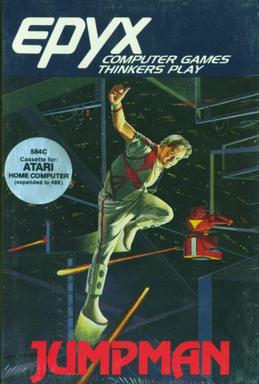
Jumpman is a platform game written by Randy Glover and published by Epyx in 1983. It was developed for the Atari 8-bit computers, and versions were also released for the Commodore 64, Apple II, and IBM PC compatibles.

Miner 2049er is a 1982 platformer game developed and published by Big Five Software in December 1982. It is set in a mine, where the player controls the Mountie Bounty Bob. The player controls Bounty Bob through multiple levels of a mine, with the goal of traversing all of the platforms in each level all while avoiding enemies and within a set amount of time.
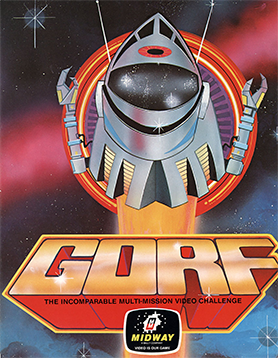
Gorf is an arcade video game released in 1981 by Midway Manufacturing, whose name was advertised as an acronym for "Galactic Orbiting Robot Force". It is a fixed shooter with five distinct levels, the first of which is based on Space Invaders and another on Galaxian. The game makes use of synthesized speech for the Gorfian robot which taunts the player, powered by the Votrax speech chip. Gorf allows the player to buy two additional lives per quarter before starting the game, for a maximum of seven lives.

Epyx, Inc. was a video game developer and video game publisher active in the late 1970s and 1980s. The company was founded as Automated Simulations by Jim Connelley and Jon Freeman, originally using Epyx as a brand name for action-oriented games before renaming the company to match in 1983. Epyx published a long series of games through the 1980s. The company's assets are currently owned by Bridgestone Multimedia Group Global.

B.C.'s Quest for Tires is a horizontally scrolling video game designed by Rick Banks and Michael Bate and published by Sierra On-Line in 1983. Versions were released for the Commodore 64, IBM PC, Atari 8-bit computers, ColecoVision, ZX Spectrum, MSX, and Apple II. Based on the comic strip B.C. by Johnny Hart, BC's Quest for Tires is similar to Irem's Moon Patrol from the previous year. A wheel-riding caveman is always moving forward through horizontally scrolling levels, and the player jumps or ducks as obstacles approach. The game's title is a play on the contemporaneous film Quest for Fire.
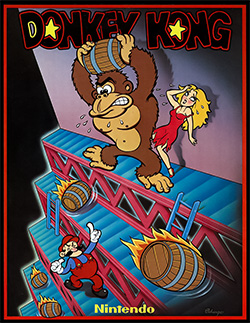
Donkey Kong is a 1981 arcade video game developed and published by Nintendo. As Mario, the player runs and jumps on platforms and climbs ladders to ascend a construction site and rescue Pauline from a giant gorilla, Donkey Kong. It is the first game in the Donkey Kong series and Mario's first appearance in a video game.
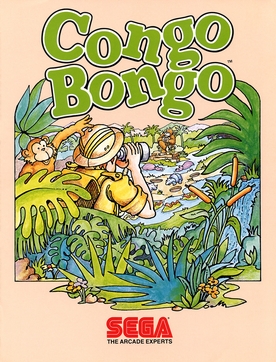
Congo Bongo, also known as Tip Top, is a platform game released as an arcade video game by Sega in 1983. A message in the ROM indicates it was coded at least in part by the company Ikegami Tsushinki. The game is viewed in an isometric perspective, like Sega's earlier Zaxxon (1982), but does not scroll. Numerous home ports followed.

One on One: Dr. J vs. Larry Bird, commonly known as One on One, is a basketball video game written by Eric Hammond for the Apple II and published by Electronic Arts in 1983. It was initially ported to the Atari 8-bit computers, ColecoVision, Commodore 64, and IBM PC compatibles. Versions followed for the TRS-80 Color Computer, Classic Mac OS, Amiga, and ZX Spectrum. In Europe, the publisher was Ariolasoft. Atari Corporation released an Atari 7800 port in 1987.
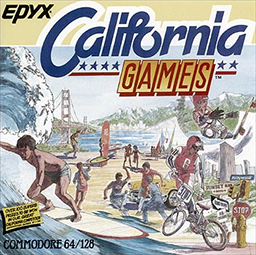
California Games is a sports video game released by Epyx for the Apple II and Commodore 64 in 1987. Branching from their Summer Games and Winter Games series, this game is a collection of outdoor sports purportedly popular in California. It ported to other home computers and video game consoles and was the pack-in game for the Atari Lynx when that system launched in 1989. The game was successful and spawned a sequel, California Games II.

H.E.R.O. is a video game designed by John Van Ryzin and published by Activision for the Atari 2600 in March 1984. The game has players control Roderick Hero who traverses a mineshaft avoiding enemies and hazards to rescue trapped miners. He travels through the mines equipped with a hoverpack that allows him to traverse the game levels as well as bombs and laser that let him destroy walls and defeat enemies respectively.
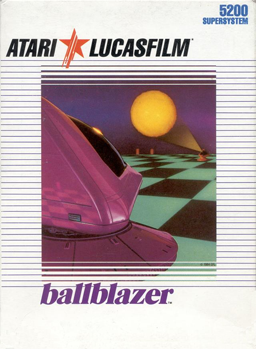
Ballblazer is a futuristic sports game created by Lucasfilm Games and published in 1985 by Epyx. Along with Rescue on Fractalus!, it was one of the initial pair of releases from Lucasfilm Games, Ballblazer was developed and first published for the Atari 8-bit computers. The principal creator and programmer was David Levine. The game was called Ballblaster during development; some pirated versions bear this name.
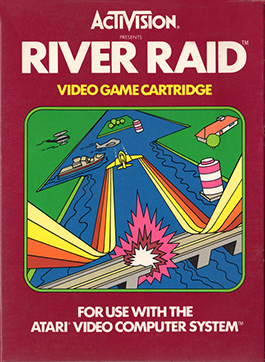
River Raid is a video game developed by Carol Shaw for the Atari Video Computer System and released in 1982 by Activision. The player controls a fighter jet over the River of No Return in a raid behind enemy lines. The goal is to navigate the flight by destroying enemy tankers, helicopters, fuel depots and bridges without running out of fuel or crashing.

Drol is a video game published by Broderbund in 1983. It was written for the Apple II by Benny Aik Beng Ngo, then ported to the Commodore 64 and Atari 8-bit computers. Versions were released for the SG-1000 in 1985 and Amiga in 1991.
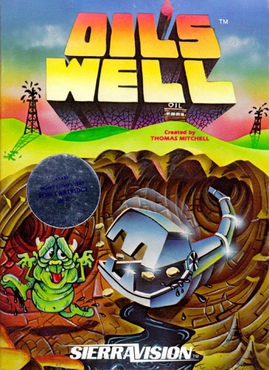
Oil's Well is a video game published by Sierra On-Line in 1983. The game was written for the Atari 8-bit computers by Thomas J. Mitchell. Oil's Well is similar to the 1982 arcade game Anteater, re-themed to be about drilling for oil instead of a hungry insectivore. Ports were released in 1983 for the Apple II and Commodore 64, in 1984 for ColecoVision and the IBM PC, then in 1985 for MSX and the Sharp X1. A version with improved visuals and without Mitchell's involvement was released for MS-DOS in 1990.

Frogger II: ThreeeDeep! is a video game released in 1984 by Parker Brothers for the Apple II, Atari 8-bit computers, Atari 2600, Atari 5200, ColecoVision, Commodore 64, and IBM PC compatibles. It is a sequel to the 1981 Konami Frogger arcade video game and has similar gameplay.

Gateway to Apshai is an action-adventure game for the Commodore 64, ColecoVision and Atari 8-bit computers. It was developed by The Connelley Group and published by Epyx in 1983 as a prequel to Temple of Apshai. It is a more action-oriented version of Temple of Apshai, with smoother and faster graphics, streamlined controls, fewer role-playing video game elements, and fewer room descriptions.

Brain Strainers is a music video game released for the Atari 8-bit computers and Commodore 64 in 1983 and ColecoVision in 1984. It contains two sub-games, one of which is a clone of the popular 1970s audio game, Simon. It is notable for being one of the earliest music video games to employ pitch-based gameplay in the Clef Climber portion of the game.
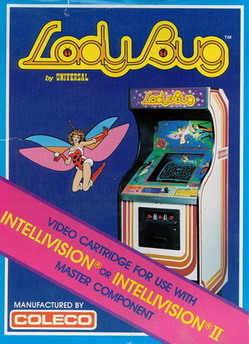
Lady Bug is a maze chase video game produced by Universal and released for arcades in 1981. Its gameplay is similar to Pac-Man, with the primary addition of gates that change the layout of the maze, adding an element of strategy to the genre. The arcade original was relatively obscure, but the game had wider recognition and success as a launch game for the ColecoVision console.

Pitstop is a 1983 racing video game developed and published by Epyx for the Atari 8-bit computers, ColecoVision, Coleco Adam, and Commodore 64. A sequel, Pitstop II, was released in 1984.

Threshold is a space-themed fixed shooter written by Warren Schwader and Ken Williams for the Apple II and published by On-Line Systems in 1981. Inspired by Sega's Astro Blaster arcade video game, Threshold introduces many enemy ship types and wave formations as the game progresses. Reviewers found the variety distinguished the game from the many similar shoot 'em ups.





















